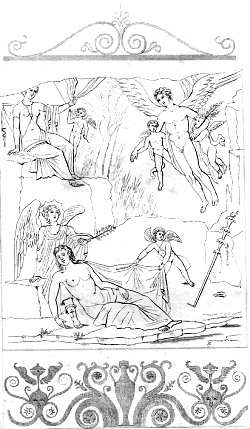Plate LXXXIII - Dream of Rhea
 |
Plate LXXXIII is a picture which, probably, was
taken from the house of Ceres, but was removed before
the author saw it. It then went under the name of
Flora and Zephyr ; and, as usually happens when
so few are really possessed of good taste, this, which
is, in fact, one of the worst compositions of the
ancients, has been more admired, and has been the
subject of more praise and more dissertations, than any
thing at Pompeii. |
M. Raoul Rochette, in a newly published work on Pompeii,
has, lastly, given a large plate in folio of this
composition.
The scene he pronounces to be the Lucus Martis : the guardian
nymph is Pasithea, the wife of Hypnos. The wings of the male
divinity in the air are black, and those on his head are the
symbol of dreams. Mars is the descending god.
Whatever may be the subject, neither the figures nor the
grouping have any merit. The male is devoid of grace, and is
exceedingly clumsy, while the sleeping female is absolutely
ugly.